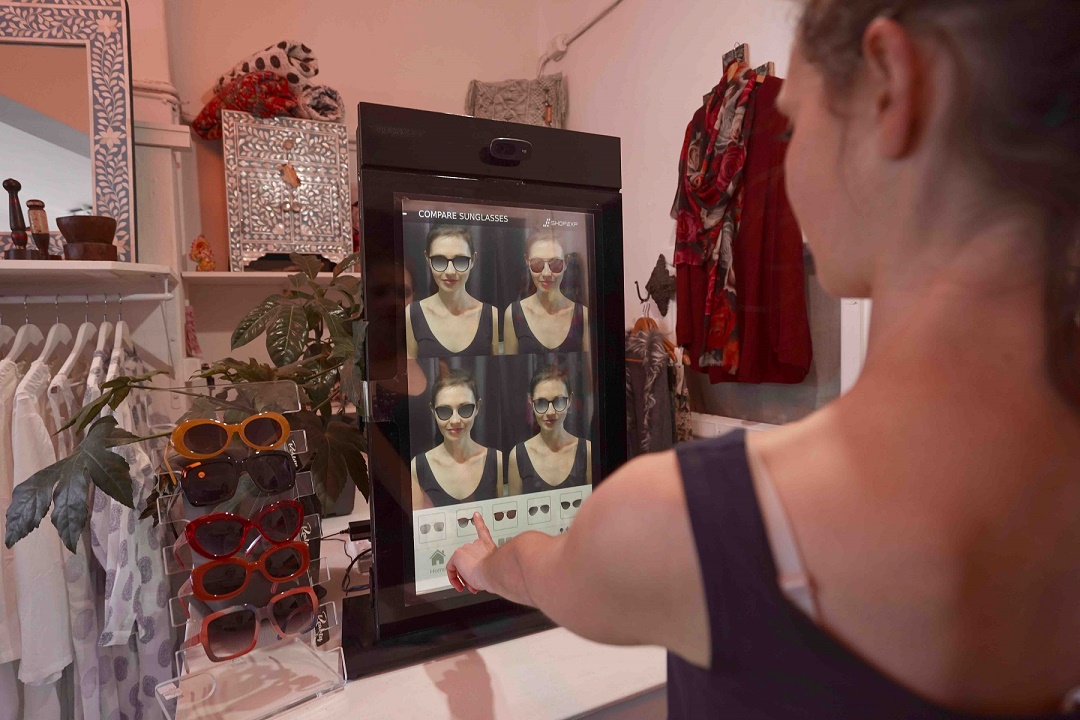Chandra Panda’s ‘smart mirror’ joins a host of augmented-reality (AR) innovations that are blurring the lines between the real world and the virtual world.
Panda, a developer by trade, has built a software ecosystem that interfaces with a camera-equipped display designed to be hung on the wall in retail stores.
The ‘smart mirror’, which debuts at this week’s Online Retailer event, uses a camera and some smart AR software to overlay computer models of the retailer’s garments and accessories onto your body.
Wave your arm, and the sleeve of that blouse waves too. Wave your hand, and you can try on a different colour.
Put on some sunglasses, and they stay superimposed on your face as you bob your head around.
Turn around, and you can see whether your bum really does look big in that.
“This is the future,” Panda said, “where people want more experiences in the store. They want something new every time.”
It’s like Snapchat filters on steroids, and it’s the latest in a string of AR innovations that hit the mainstream with Pokemon Go and has, more recently, spawned projects such as Facebook’s AR ads, Woolworths’ checkout-free supermarkets, and detailed interactive anatomy models that float in space in front of you.

The smart mirror at work. Image: Supplied
Playing AR’s long game
While early AR played heavily on its novelty value, apps that manipulate the reality you see are increasingly attracting attention and – in the case of the Faceapp simulated-ageing app that recently went from novelty toy to perceived privacy nightmare and global pariah overnight – concern.
Photorealism has gotten so good, in fact, that the entirety of the recently-released Lion King reboot was digitally rendered: no animals were used to make the film, yet it has the hair-accurate vérité of a David Attenborough nature documentary.
Concerns about propaganda-spouting deepfake videos aside, the penetration of AR into everyday life is rapidly taking us from the obvious simulacrum of Second Life to a convincingly different reality based on a digitised, analysed and customised version of the world you live in – and the life you live.
Panda knows this, and he has big plans for the Smart Mirror beyond just letting you try on fascinators for the spring racing carnivals.
An evolving back-end ecosystem will provide recommendations from retailers’ product catalogues, use Apple’s iBeacon to make the system user-aware, support analytics to help retailers track what people try and buy – or don’t – and deliver a portable avatar that will let users play dress-up dolls on their phones anywhere they are.
Analytics will create product matches, allowing the system to make personalised offers or recommend a top to go with those jeans you’re trying on.
“This is a bridge idea for retailers to get customers into stores and give them a new generation, AI-enabled digital experience,” Panda explained, noting that he plans to work with retailers to customise the experience as they see fit.
“If someone wants to set up a pop-up store somewhere where they don’t have a physical presence, they don’t have to spend much on hiring a physical store.”
Augmented reality, or just the new reality?
Time will tell whether the mirror’s gimmick value will bring shoppers through the doors of inertia-plagued retailers who are desperate for new ideas to stave off the onslaught of online retail.
As AR apps are increasingly refined, the technology is positioned to become a gateway drug to a world where it becomes increasingly difficult to tell what’s real from what’s not.
Analyst firm Markets And Markets, for one, recently projected that the global AR market will grow from $US4.2b ($A6b) in 2017 to $US60.6b ($A86.3b) by 2023 – with 40.3 per cent annual growth driven largely by the use of AR in healthcare, retail, e-commerce, and enterprise applications.
As Facebook refines its AR toolkit and firms like Melbourne-based Plattar simplify the process of creating AR, opportunities to tweak your reality will become increasingly accessible – and increasingly convincing.
Richer AR ecosystems will allow users to model themselves in apps, doing everything from visualising themselves in designer clothes or expensive cars to simulating entire holidays with photorealistic fakes.
Ultimately, the increasing integration of AR techniques into your everyday interactions will create a digital version of yourself based not, as in Second Life, on your own design – but on carefully monitored and curated characteristics of your own personality and behaviour.




.jpg)





